Einfluss beta-adrenerger Regulation auf die Elektrophysiologie und Erregungsausbreitung im menschlichen Ventrikel
- Forschungsthema:Modellierung & Simulation
- Typ:Studienarbeit
- Betreuung:
- Bearbeitung:
Studienarbeit
Electrophysiological models of human ventricular myocytes deliver important, quantitative insights in the genesis of action potentials under both physiological and pathological conditions. Although the influences of the autonomic nervous system (sympathetic / parasympathetic) is well established quantitative models of the regulatory system were missing. Recently Saucerman et al. published a model describing the effects of beta-adrenergic regulation on rat ventricular myocytes.
This model has been transferred to human electrophysiology and further expanded. The aim of this simulation study is to investigate the effects of beta-adrenergic regulation on both single-cell and tissue level.
The following question will be answered during the course of this project:
- What effects can be seen with respect to transmural dispersion of repolarization (TDR)?
- What effects does the phosphorylation of Gap Junctions have?
- What effects does adrenergic regulation have on the ECG?

This is a schematic representation of the beta-adrenergic regulation mechanisms. Key-roles are assigned to the second messenger cAMP and the protein kinase A (PKA)

